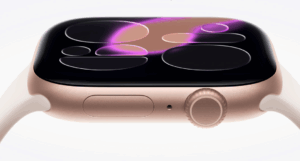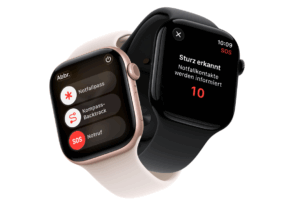CUPERTINO – For years, travelers with diabetes or pre-diabetic conditions have dreamed of a day when checking blood-glucose levels would no longer require test strips, lancets, or small vials carried through airport security. The idea of simply glancing at one’s wrist for instant, non-invasive readings sounds almost utopian — especially for frequent flyers who juggle jet lag, unfamiliar cuisines, and unpredictable daily routines.
That dream seemed to edge closer to reality when rumors surfaced that Apple was developing a non-invasive glucose-monitoring sensor for its Apple Watch line. Early reports suggested the technology might debut within a few years, sparking excitement — and, perhaps, unrealistic expectations — among travelers hoping for a discreet and effortless way to track their metabolic health on the go.
But as of late 2025, that innovation remains just over the horizon. While Apple’s latest wearable, the Apple Watch Series 11, introduces sophisticated health analytics and even AI-driven hypertension alerts, glucose monitoring remains a research project rather than a retail feature.
Still, the race is far from over — and the stakes, especially for travelers, couldn’t be higher.
Why This Matters on the Road
When you’re halfway across the world, managing blood sugar isn’t just a medical concern — it’s a logistical one. Meal times shift. Airline catering rarely lists carbohydrate content. A long-haul flight or a late-night business dinner can wreak havoc on even the most disciplined routines.
Portable glucometers have helped, but they add weight, require consumables, and can draw unwanted attention during customs checks. Continuous glucose monitors (CGMs), such as the Dexcom G7, have alleviated some of those burdens. The G7, approved for direct Apple Watch connectivity in 2024, allows travelers to view real-time glucose data from a subdermal sensor without carrying a phone. For now, that pairing — invasive though it remains — offers the most reliable solution for frequent travelers seeking accuracy and discretion.
A non-invasive system built directly into a smartwatch, however, would redefine convenience. It would mean no adhesives, no sensors under the skin, and no replacement cycles — just a wristwatch capable of assessing glucose through light, sweat, or other biosignals. The potential implications for global travelers, particularly in regions where diabetes care infrastructure is limited, are enormous.
Apple’s Long Road to Non-Invasive Glucose
Inside Apple’s health labs, work on glucose detection reportedly dates back more than a decade. The company has explored optical and spectroscopic sensing, attempting to measure blood sugar by analyzing light absorption through the skin. But despite billions invested and years of research, engineers face a fundamental obstacle: the human wrist simply doesn’t reveal glucose levels with the same clarity as a blood sample.
Industry insiders now suggest that the earliest feasible rollout — perhaps under the Apple Watch 13 or 14 — could come around 2027 or later, assuming the sensors achieve both technical reliability and regulatory clearance. That’s an ambitious timeline given that medical-grade accuracy is required for FDA approval.
In the meantime, Apple is enhancing its existing suite of health features. The Series 11 includes AI-powered Hypertension Notifications and improved Sleep Scores, designed to detect long-term health patterns through continuous monitoring of pulse, temperature, and movement. For most users, these upgrades feel evolutionary rather than revolutionary — welcome, yes, but not life-changing for those managing glucose-sensitive conditions.
Huawei and Samsung: Quiet Contenders
While Apple dominates the headlines, Huawei and Samsung are also chasing the holy grail of non-invasive glucose tracking. Huawei’s Watch 4 series, released in China, introduced a “High Blood Sugar Risk Assessment” tool that estimates risk levels using multiple biosignals rather than actual glucose readings. It’s a cautious, data-driven first step — informative, but not diagnostic.
Samsung, meanwhile, has publicly confirmed that it is exploring optical glucose sensing for future Galaxy Watch models. Company engineers are said to be testing infrared absorption technologies that could one day approximate glucose values without piercing the skin. Yet Samsung, too, remains in the research phase, with no product roadmap or release window announced.
Across the Pacific, startups like Know Labs (developer of “Bio-RFID”) and Nemaura Medical (“SugarBEAT”) are experimenting with light- and frequency-based sensing systems. These efforts, while promising in laboratory conditions, face the same obstacles that have delayed Apple: biological complexity, signal noise, and stringent medical regulations.
For now, travelers must temper optimism with realism — the breakthroughs are coming, but slowly.
The Battery Benchmark
If there’s one metric where Apple lags conspicuously behind its Asian competitors, it’s battery life.
While Huawei’s watches routinely deliver 10 to 14 days of endurance on a single charge — a blessing for travelers hopping time zones — the Apple Watch Series 11 tops out at about 24 hours of normal use, or roughly 38 hours in low-power mode. That means nightly charging remains a ritual, which can complicate life on long journeys or in remote destinations.
Apple’s engineering team argues that advanced displays and health sensors demand more energy than simpler trackers, and there’s truth to that. Still, for anyone crossing continents, battery anxiety is real. Until Apple closes that gap, Huawei and other brands will retain a loyal following among travel-oriented users who value endurance above ecosystem integration.
Regulators, Reality, and Responsibility
Even if Apple — or any competitor — perfects non-invasive glucose sensing, another challenge looms: regulatory approval. The U.S. Food and Drug Administration (FDA) has repeatedly warned consumers not to rely on unverified smartwatch apps or sensors claiming to measure blood sugar. Devices that fail to meet clinical standards could deliver dangerously misleading results, especially for insulin-dependent individuals.
For that reason, Apple and others are proceeding cautiously. Sources close to the company say its health-team mantra is “accuracy before novelty.” In other words, Apple will not release a glucose-tracking watch until its readings rival the precision of traditional glucometers and pass full medical review — a process that could take years.
A Traveler’s Timeline: The Smart Move for Now
So, should the world’s travelers hold out for Apple’s next big leap? The answer depends on priorities.
If you want the longest battery life and strong baseline health tracking, Huawei remains the clear choice — especially for those already in its ecosystem.
If you’re seeking the richest integration of devices and medical apps, Apple’s ecosystem shines: pairing an Apple Watch Series 11 with a Dexcom G7 sensor delivers FDA-approved glucose readings directly to the wrist, even without an iPhone nearby. It’s not non-invasive, but it’s dependable, discreet, and globally supported.
And if your goal is to wait for true, needle-free glucose tracking, patience will be key. Every major player — Apple, Samsung, Huawei, and others — is investing heavily, but realistic analysts forecast commercial readiness closer to the late 2020s, not 2025 or 2026.
The Future of Health at 30,000 Feet
Imagine a future where long-haul passengers can check their glucose trends mid-flight, where mountaineers in Nepal or consultants in Nairobi can monitor blood sugar through thin air and poor Wi-Fi — all without breaking skin or carrying supplies. That’s the promise driving this technological race.
For now, the smartwatch on your wrist may not yet replace a glucometer, but it’s learning fast. Apple’s next chapters — and its rivals’ — could turn that promise into a new era of digital health freedom, one that finally lets travelers manage chronic conditions as easily as checking the time.
Until then, we keep watching.
(hz)
Photo: Apple


